Module 1
Synchronous Machines: Types – selection of alternators – constructional
features of cylindrical and salient pole machines.
Armature windings: different types – phase grouping – single and double layer,
integral and fractional slot winding – emf equation – distribution factor – coil span
factor – tooth harmonic ripples – skewed slots – harmonics, elimination of
harmonics – revolving magnetic field.
Module 2
Armature Reaction – Synchronous reactance – circuit model of synchronous
machine.
Regulation – predetermination – emf, mmf and potier methods, saturated
synchronous reactance – Phasor diagrams – short circuit ratio – two-reaction
theory – Phasor diagram – slip test – measurement of Xd, Xq, losses and efficiency
of synchronous machines.
Module 3
Parallel operation of alternators – load sharing – synchronising power and torque
– governor characteristics – method of synchronising – synchroscope.
Synchronous Motor: Principles of operation – torque and power relationships –
Phasor diagram – hunting in synchronous machines – damper winding – starting
of synchronous motors.
Module 4
Synchronous machines connected to infinite bus – power angle characteristics of
cylindrical rotor and salient pole machines – reluctance power – steady state
stability limit – V-curves – inverted V-curves – O-curves – synchronous
condenser – symmetrical short circuit of unloaded alternators – steady state,
transient and sub-transient reactance – current variation during short circuit.
Module 5
Generalised Machine Theory: Dynamic representation of generalised machines
– formation of emf equation – expression of power and torque – representation of
DC machines – synchronous machine and Induction motor.
Excitation systems: different types – comparison – exciter ceiling voltage –
excitation limits – exciter response – methods of increasing the response of an
exciter.
Brushless Alternators: Principle of operation constructional features – excitation
methods – voltage regulation.
2010
